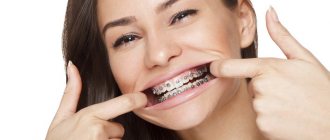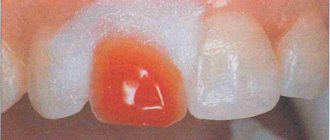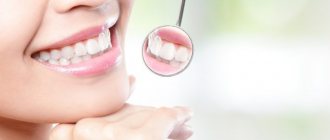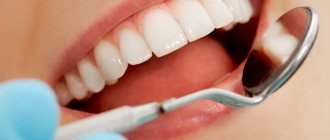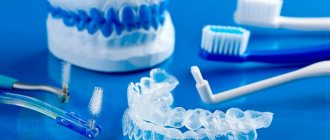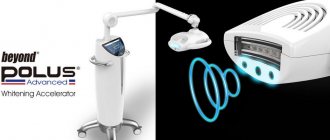Teeth whitening is a fairly popular procedure that is in high demand among many people, regardless of gender. This procedure allows you to restore the natural color of your teeth in a short period of time, remove yellow and dark enamel color and restore the beauty of a snow-white smile. But still, one should not forget about the unpleasant consequences of this procedure, especially if the main rules are not followed during it. Therefore, before resorting to the procedure, it is worth finding out whether whitening is harmful to tooth enamel.
What causes whitening
Professional teeth whitening is often carried out using special chemical gels. Due to the exposure of the outer and inner layers of enamel to the chemical components of these products, coloring pigments are destroyed. As a result, the unpleasant yellow or gray tint disappears when exposed to aggressive chemicals. For example, many products designed to whiten tooth enamel contain high levels of hydrogen peroxide with phosphoric acid. If these products are used incorrectly, they can destroy not only the pigments on the surface of the enamel, but also cause serious harm to the teeth. It is for this reason that it is important to carefully choose the clinic and doctor where this procedure will be performed.
Chemical whitening is lightening by applying a special gel to the tooth. It is important to properly cover the gums with a special protective composition; only then can the whitening gel be applied to the teeth.
Features of laser whitening
Many people believe that laser treatment is a dangerous procedure because it contains an increased level of radioactive radiation. But this is not true at all. This statement has no evidence and is not confirmed in any way.
Attention! Laser whitening is widely used to lighten tooth enamel. This procedure is quite quick, simple and absolutely painless. In addition, according to numerous scientific studies, it has been proven that this procedure is not harmful to health.
During this procedure, a special preparation containing about 20-25% hydrogen peroxide is applied to the surface of the tooth enamel. Next, under the influence of the laser, the pigmenting particles of the enamel of the teeth are destroyed. After this procedure, no disorders appear in the structure of the tooth enamel, there is no increase in the sensitivity of the teeth, and no bleeding gums are observed. In addition, laser whitening can be used many times.
Laser teeth whitening is a method of professional teeth whitening; this method is based on the use of a laser and a special gel. This method allows you to correct each tooth individually, thereby achieving a uniform color of tooth enamel.
Effective recipes
The influence of herbs, fruits, oils and other substances that are always at hand is minimal. But if used incorrectly, even they can cause harm to health.
Hydrogen peroxide
It has a strong effect on tooth enamel and can contribute to its damage.
At home, using peroxide is dangerous because it is difficult to determine the time of use and the amount of this product.
Due to overexposure or inappropriate combination with other active ingredients, sensitivity or pain in the teeth may occur.
Soda
It is a mild abrasive component, however, it may scratch the enamel when applied. Destruction of the upper layer of teeth also occurs due to overexposure of the substance or when it is strongly rubbed.
The use of soda contributes to bleeding gums, thinning enamel, irritation or rashes on the soft tissues of the oral cavity.
What is tooth enamel hypoplasia and what modern methods of treating it exist? Let’s figure it out together. Come here if you are interested in the drugs used for local anesthesia in dentistry.
At this address https://dr-zubov.ru/ortodontiya/diastemy-i-tremy/shhel-mezhdu-perednimi-privlekatelnaya-izyuminka-ili-defekt.html we will talk in detail about how to remove the gap between the front teeth.
Lemon
Bleaching with citric acid, pulp or zest should be done very rarely. This is due to the strong effect of acid, which dissolves calcium salts.
If its concentration is high and the procedure time is exceeded, microcracks may appear on the enamel, and the teeth will become susceptible to bacterial attacks.
After clarification with lemon, be sure to rinse your mouth with clean water to remove any remaining juice or pulp of the fruit.
Failure to follow the rules for using lemon can cause serious health problems. Dentists often correct unwanted results from at-home procedures.
Tea tree oil
This product is absolutely safe if you do not exceed its norm. To whiten teeth, it is enough to use 1-2 drops of oil.
Otherwise, there is a high probability of redness or irritation on the gums. It does not harm the enamel.
Special pastes
Sometimes manufacturers write on the packaging that the product contains 1-2% hydrogen peroxide. However, many doctors consider such statements to be a marketing ploy.
Such a low concentration is not capable of giving the surface layer a lighter shade. Thus, pastes with a whitening effect are absolutely harmless to teeth.
https://youtu.be/j4qBjO5ftJM
Lightening technique Zoom 3
This type of lightening is quite popular; its effect is similar to the laser whitening procedure. Features of this whitening method:
- During the Zoom 3 procedure, a special two-component gel solution is applied to the surface of the teeth located in the smile area. This gel is based on a high content of hydrogen peroxide with a concentration of 25% and an alkaline base;
- The lightening process occurs due to exposure to the rays of a polarizing lamp. As a result, the enamel heats up under the influence of the light of this device, so this procedure is considered not as safe as the previous one;
- Due to exposure to a highly active element and the influence of temperature, the patient may experience pain;
- During this procedure, oxygen, under the influence of a catalyst, penetrates microcracks in the teeth and causes destruction of the surface layer.
After this procedure, unpleasant symptoms may appear in the form of increased sensitivity or spotting on the enamel surface. Darkening of the enamel may also occur.
Photo teeth whitening using a Zoom lamp is the use of gels with a high content of hydrogen peroxide or carbamide peroxide and a special lamp, the main light spectrum of which is in the ultraviolet zone.
We asked, we answer
Before and after the whitening procedure, patients are faced with a number of questions that interest them. Let's look at the most popular ones:
What should I do if my teeth hurt after whitening?
Many people notice that after whitening their teeth hurt for some time. In order to get rid of unpleasant sensations, it is necessary to use products to reduce tooth sensitivity.
You can find out which one is right for you by visiting your dentist. It is best to consult the same doctor who did the whitening. After the procedure, you need to start using toothpastes for sensitive teeth.
After the procedure: what is possible and what is not?
After the teeth whitening procedure, even more thorough oral care is necessary.
You should definitely know what not to eat after whitening. During the first few days, you will have to rid yourself of food and drinks that will cause pain due to dental hypersensitivity.
Do not consume: coffee, berries, carbonated drinks, tea, tobacco, beets, mustard, ketchup, chocolate, dark grapes, red wine and sauce, soy sauce. All this will affect the color of the enamel.
Don't skip brushing your teeth. This must be done at least three times a day. It is better to buy a brush of medium hardness, and choose a toothpaste for sensitive teeth.
Have your teeth professionally cleaned by your dentist once a year. This will help maintain the whitening results.
Carrying out the procedure during pregnancy
Maternity leave during pregnancy can be spent not only on carrying a child, but also on yourself. There is a lot of free time for cosmetic procedures, but can an expectant mother do them?
Pregnancy is a direct contraindication to teeth whitening.
The procedure does not pose any danger to the mother or unborn child. But is it worth doing it at a time when the body is weakened and all forces are aimed at creating a new life? A pregnant woman’s body already has a lack of calcium and loose enamel, and chemicals will only aggravate the situation.
If you are expecting the birth of a child, you can do a cleaning, which will also whiten your teeth a couple of shades. In addition, the procedure is useful and prevents the appearance of tartar and other oral problems.
Can children's teeth be whitened?
No one can prevent a parent from bringing their child for cosmetic teeth whitening. But you must understand that the procedure entails many consequences; you should not spoil your child’s enamel from childhood.
Solving smile problems can be more humane. The child can undergo physical cleaning, which will get rid of plaque and other formations on the surface of the teeth.
Upon reaching the age of eighteen, a person will be able to decide for himself whether he needs a procedure to help him achieve a Hollywood smile or not.
Amazing White
During this procedure, a special gel is used for lightening, which contains an increased level of hydrogen peroxide with a concentration of 16%. Since the concentration of the active component is lower than in the gel used during the Zoom 3 procedure, there is not a strong destructive effect on the teeth. Before carrying out this procedure, you must be examined by a dentist. If teeth have depleted enamel, then this whitening method is contraindicated. Otherwise, it may cause surface porosity and increased sensitivity. But it is worth paying attention that during clarification a lamp with cold light is used. This device is quite safe for the structure of tooth enamel. Due to the fact that during this procedure there is no heating of the teeth, the likelihood of painful sensations is reduced.
The “Amazing White” whitening system is based on the principle of releasing atomic oxygen from hydrogen peroxide under the influence of cold light from a specialized LED lamp. As a result, the pores of the tooth enamel are cleaned and the dark components are discolored.
Opalescence
Whitening using this method is carried out due to the chemical action of a special two-component gel. This product contains hydrogen peroxide and urea. After this gel is applied to the surface of the enamel, oxygen is released. Due to this component, the coloring elements are destroyed. This bleaching method has a milder effect and is one of the safest methods of lightening. It does not cause deterioration of the surface layer. This type of whitening even brings benefits - nutrition and strengthening of the surface layer due to potassium nitrate and sodium fluoride.
Opalescence is an effective and gentle whitening system developed by the leader in the dental market (USA).
Categorical prohibitions
Like any cosmetic or medical procedure, whitening has its contraindications.
Bleaching is strictly prohibited:
- in any trimester of pregnancy and during breastfeeding;
- intolerance to hydrogen peroxide and other components of whitening gels;
- strong sensitivity;
- caries and wedge-shaped lesions;
- worn tooth surfaces;
- baby teeth;
- diseases of the joint that helps keep the mouth open (you cannot close your mouth during the procedure, and it can be quite long);
- hemophilia and diabetes mellitus (possibility of mechanical damage to the gums or chemical burn);
- wearing braces (the procedure simply does not make sense);
- children up to 16 years of age.
There are also indications for refusing the whitening procedure that are not critical:
- age up to 20 years;
- carrying out procedures several times in a row over a short period of time;
- the presence of a large number of fillings, crowns and other artificial materials in the dentition (they will not whiten, and the procedure will simply be pointless with a large difference in color);
- periodontal diseases, whitening can be carried out only after complete recovery.
In-canal
This method differs in that during it a deeper whitening occurs, which affects not only the enamel layer, but also the dentin. This method can only be used for those dental units in which the nerve has previously been removed. It is worth noting that during this procedure the main impact is on dentin, which has low strength. As a result, the crown becomes thinner. This method of whitening is also dangerous because it leads to complete destruction of the tooth - cracks, damage, and chips form. Features:
- First, the doctor uses a drill to create cavities that will be needed for applying the bleaching agent;
- Typically, several procedures are performed to obtain a natural color;
- It is allowed to use this clarification method no more than 3-4 times.
Endo-teeth whitening is a method of intra-canal whitening by introducing a special gel with a whitening effect into the tooth cavity, which was previously depulped.
How safe is teeth whitening?
The answer to this question directly depends on the bleaching method. Cleaning with chemicals, mechanical means, gels and pastes have different effects on both our teeth and the general condition of the body. In addition, you need to select the whitening method individually, focusing on the characteristics of the body and susceptibility to allergies.
Also remember that during whitening (regardless of the method), the enamel wears off and becomes thinner, teeth lose their natural strength and are more susceptible to destruction. Yellow enamel is stronger, so you should not whiten your teeth too often - this can lead to significant thinning of the enamel. On average, you can whiten your teeth once or twice a year, but again, you need to consult with your dentist. Some chemicals can also soften the enamel and make it loose and porous, so consultation with a specialist before the procedure is mandatory. The doctor will not only select the most optimal option for you, taking into account its characteristics, but will also find out individual intolerance to individual components, possible allergic reactions, and determine the condition of the teeth before the procedure.
In-office whitening methods
In order to understand the harm caused by in-office whitening methods, it is worth carefully considering the types of these methods:
- Using mouthguards with a special gel composition. The danger with this lightening method usually lies in the fact that many manufacturers of these products use a gel with a high concentration of the active component. As a result, this can negatively affect dental health;
- Whitening strips. These products are secured to the teeth. On the inner surface of the strips there is a layer of active product. This whitening method is considered quite dangerous because the concentration of active elements in the product on the strips always exceeds the recommended standards. If these products are used carelessly, a person may experience serious damage to the enamel structure;
- Varnish. This product is applied to the surface of the enamel.
Attention! Varnish can give your smile a snow-white color. Many varnishes contain remineralizing components, which improve the condition of teeth.This whitening method is considered harmless, but not permanent. The varnish crumbles quickly, so frequent re-bleaching is required;
- Using a special pencil. This bleaching method has a fairly low effect, so it does not pose any particular health hazard. But many manufacturers of this type warn about increased tooth sensitivity;
- White Light System. This procedure is analogous to bleaching using a tape. The only difference is that it takes a long period to achieve a positive result.
In-office whitening is a quick and convenient way to care for your teeth, which allows you to carry out this procedure in a place convenient for you and at any time. These could be special trays with gel, whitening strips, pencils and other systems.
Professional techniques
I hasten to remind you that only milk teeth and the teeth of very young people are white. With age, the enamel turns yellow - this is the norm, and you should not spoil it with whitening if you do not want to get holey teeth.
However, if a snow-white smile makes you visually younger, then many are willing to risk their health in the name of eternal youth. It’s better to decide on professional whitening: at least you will be under the control of a professional.
Many dentists do not like this procedure and compare teeth whitening to hair bleaching: even with the use of the most modern bleaching agents, the enamel structure is still damaged.
But the yellowness of teeth today scares many more than caries or gum disease in a year. Advertising slogans have an effect on the mind, but there are no medical indications for teeth whitening. The fashion for lightening enamel appeared after Hollywood was conquered by a snow-white smile.
Marilyn Monroe
. Dentists quickly realized that they could make money from people’s craving for beauty, which they still use today, without always warning their patients about the dangers of whitening. And they themselves are happy to deceive themselves, just to get closer to world standards of beauty.
Methods for whitening at home
The most gentle and simple method of teeth whitening at home is the use of special gels. The main thing is to carefully observe the amount of this product. In addition to gels, you can use other products based on available components.
Hydrogen peroxide
Hydrogen peroxide has an increased effect on the structure of teeth and can cause damage to the structure of tooth enamel.
Important! It is dangerous to use peroxide yourself at home, especially if this product has not been used before. If suddenly it is overexposed, then the likelihood of destruction of the enamel increases many times.
In addition, severe sensitivity and pain may occur.
Baking soda
This component is an abrasive element with a soft structure. However, when used for whitening, it may scratch the enamel structure. This substance can cause destruction of the top layer due to prolonged exposure of the substance or strong rubbing. In addition, using baking soda can cause the following conditions:
- Increased bleeding of gums;
- Thinning of enamel;
- Irritation;
- The appearance of a rash on the soft tissue area of the mouth.
Lemon
Lemon juice, zest, and pulp are sometimes used for whitening. However, this component is not recommended to be used too often. The acid contained in lemon juice causes the dissolution of calcium salts during its action.
Important! If juice or pieces of lemon are kept on the surface of the teeth for a long period, microcracks will eventually form on the surface of the enamel and areas will open up for the active penetration of various pathogenic organisms into the tooth structure.
Be sure to rinse your mouth after lightening with lemon to prevent unpleasant consequences. This will clear your mouth of various lemon pieces and fibers. It is important to remember that if you do not follow the important recommendations of doctors, then this whitening method can cause various health problems in the future.
Baking soda, hydrogen peroxide, and lemon are common ingredients that are often used in home whitening. They can be used individually or as a complement to making homemade cleaning paste.
Application of special pastes
On sale you can find whitening products with a fairly low concentration of hydrogen peroxide - 1-2%, but this is just advertising. In fact, teeth whitening products with such a low concentration of the main component are unable to completely whiten teeth. Since the content of the active component in these products is very small, the harm from these products will be low. These whitening pastes are absolutely harmless to teeth.
Write a comment
Olesya
December 13, 2020 at 0:57 am
Several years ago I had mechanical teeth cleaning, and last year I had laser whitening. I didn’t like mechanical cleaning at all: there were unpleasant, even very painful sensations during the procedure itself, it took a long time, and I didn’t notice any special effect. Now I understand that my teeth were simply professionally cleaned to their original enamel color. And then I was hoping to get snow-white teeth as a result, so I was disappointed. I liked laser whitening much more. It doesn't hurt and is more effective. Teeth became noticeably whiter. Sensitivity was increased only for the first couple of days, then everything returned to normal. I'm going to do laser whitening again next year.
Anna
December 15, 2020 at 12:13 pm
Until some time I considered my yellowish teeth to be a big drawback, but now I don’t bother too much, because... It is better to have healthy teeth than beautiful ones. There are a lot of negative examples. In general, yellowish teeth are the norm for people in our region. A yellowish tint even indicates dental health. To ease my conscience, every couple of months I buy whitening toothpastes in pharmacies.
Martha
May 3, 2020 at 0:00
Whitening with aggressive means is naturally harmful, the enamel becomes thinner and in general you can create a lot of problems for yourself. For example, I sometimes rinse and brush my teeth with tea tree oil, it is good for the gums and kills germs in the mouth. I don’t risk using soda and especially hydrogen peroxide. Of course, it is better to whiten your teeth at a salon when you have the money.
Diana
December 23, 2020 at 5:24 am
I have a negative attitude towards teeth whitening at home, perhaps there will be an effect, but it seems to me that you will do more harm to your teeth - damage to the gums or increased sensitivity of the enamel. Unless cleaning with activated carbon is safe. I haven’t done whitening myself, but I’m still thinking about it, after all, there is no such thing as perfectly white teeth by nature; it’s another thing to restore the natural whiteness of teeth, which was lost due to smoking, tea, coffee, etc. Professional cleaning “Air Flow” helped me a lot with this - painless, fast and inexpensive. My teeth brightened a little, but the main thing was that I really felt that they had become much cleaner; no brush or toothpaste could have cleaned all the spaces between the teeth. I did it a long time ago, I should do it again.
Gulnara
December 11, 2020 at 08:29 pm
I whiten my teeth only in the office, no more amateur activities. There was an incident that made me think about what is more valuable: health or paying several thousand for a procedure. One day I decided that professional whitening was not for me and I would make do with soda and lemon. I don’t know how I managed to find this particular recipe on the Internet. I mixed everything according to the instructions and brushed my teeth. As a result, the gums burned and awakened dormant caries in the initial stages. I had to go to the dentist to prescribe treatment for my gums.
Asya
December 13, 2020 at 3:02 am
After professional whitening, there is hellish pain. I did it for the first time, came home and realized that my teeth were aching more and more. The feeling is like when something sweet gets into a carious cavity, only in all the teeth at once and nothing can be done. And I don’t have a single strong painkiller at home, so now I’ll go to the pharmacy.
Rita Viktorovna K.
December 13, 2020 at 6:57 pm
The consequences of the procedure depend on the individual characteristics of the patient’s teeth. Many of our clients experience virtually no pain, only slight discomfort, but it goes away quickly. Patients with highly sensitive teeth tolerate whitening less well. But before we start, we ask everyone about high sensitivity, and if a person has such a problem and, knowing about it, agrees to bleaching, all responsibility rests with him. We also talk about the need to have painkillers at home.
